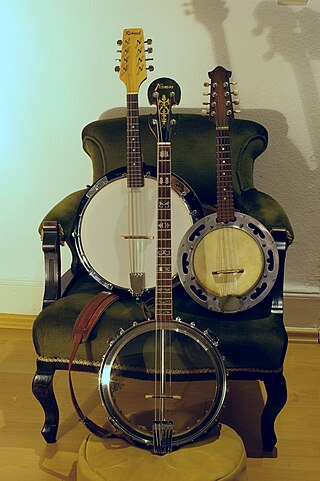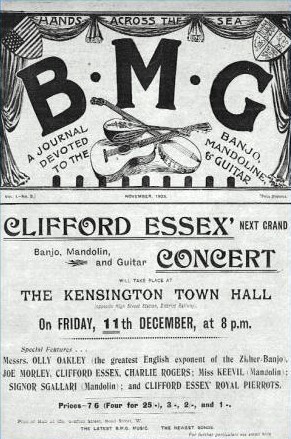The banjo is a stringed instrument with a thin membrane stretched over a frame or cavity to form a resonator. The membrane is typically circular, in modern forms usually made of plastic, originally of animal skin. Early forms of the instrument were fashioned by African Americans and had African antecedents. In the 19th century, interest in the instrument was spread across the United States and United Kingdom by traveling shows of the 19th century minstrel show fad, followed by mass-production and mail-order sales, including instruction method books. The inexpensive or home-made banjo remained part of rural folk culture, but 5-string and 4-string banjos also became popular for home parlour music entertainment, college music clubs, and early 20th century jazz bands. By the early 21st century, the banjo was most frequently associated with folk, bluegrass and country music, but was also used in some rock, pop and even hip-hop music. Among rock bands, the Eagles, Led Zeppelin, and the Grateful Dead, have used the five-string banjo in some of their songs.

A mandolin is a stringed musical instrument in the lute family and is generally plucked with a pick. It most commonly has four courses of doubled strings tuned in unison, thus giving a total of eight strings. A variety of string types are used, with steel strings being the most common and usually the least expensive. The courses are typically tuned in an interval of perfect fifths, with the same tuning as a violin. Also, like the violin, it is the soprano member of a family that includes the mandola, octave mandolin, mandocello and mandobass.

C.F. Martin & Company is an American guitar manufacturer established in 1833 by Christian Frederick Martin. It is highly respected for its acoustic guitars and is a leading manufacturer of flat top guitars. The company has also made mandolins and tiples, as well as several models of electric guitars and electric basses, although none of these other instruments are still in production.

Orville H. Gibson was a luthier who founded the Gibson Guitar Company in Kalamazoo, Michigan in 1902, makers of guitars, mandolins and other instruments.

The mandocello is a plucked string instrument of the mandolin family. It is larger than the mandolin, and is the baritone instrument of the mandolin family. Its eight strings are in four paired courses, with the strings in each course tuned in unison. Overall tuning of the courses is in fifths like a mandolin, but beginning on bass C (C2). It can be described as being to the mandolin what the cello is to the violin.

The mandolin-banjo is a hybrid instrument, combining a banjo body with the neck and tuning of a mandolin. It is a soprano banjo. It has been independently invented in more than one country, variously being called mandolin-banjo,banjo-mandolin,banjolin and banjourine in English-speaking countries, banjoline and bandoline in France, and the Cümbüş in Turkey.

A mandolin orchestra is an orchestra consisting primarily of instruments from the mandolin family of instruments, such as the mandolin, mandola, mandocello and mandobass or mandolone. Some mandolin orchestras use guitars and double-basses instead of, or as well as, the lower mandolin-family instruments.

Elderly Instruments is a musical instrument retailer in Lansing, Michigan, United States, with a reputation as a "megastore", a repair shop and a locus for folk music including bluegrass and "twang". Specializing in fretted instruments, including acoustic and electric guitars, banjos, mandolins, and ukuleles, Elderly maintains a selection of odd or rare instruments. Elderly is known as a premier repair shop for fretted instruments, as one of the larger vintage instrument dealers in the United States, and as a major dealer of Martin guitars in particular.

Bluegrass mandolin is a style of mandolin playing most commonly heard in bluegrass bands.
The Boston Ideal Banjo, Mandolin and Guitar Club was an American musical quintet composed of virtuoso artists of the banjo, mandolin, and guitar. Founded in 1887, it was reputed to be the first ensemble of fretted instrument artists on the East Coast formed for professional appearances and nationwide concert tours. The prevailing critical acclaim in major cities throughout the country was highly complimentary.

Salvator Léonardi was a mandolin virtuoso, teacher and composer. He taught in Egypt, Malta, London and Paris for more than 20 years, and also toured as a performer. Léonardi learned mandolin and guitar from an uncle, but went on to become a professional musician, studying the violin at a Naples conservatory. He won awards as a solo mandolinist at international music competitions in Florence and Rome.

Bartolomeo Bortolazzi was a performing musician, composer, author, and virtuoso of both the guitar and the mandolin. He was credited by music historian Philip J. Bone as helping to pull the mandolin out of decline.

Herbert J. Ellis was a banjo player, a mandolinist, guitar player and a composer. Music historian Philip J. Bone called him "without question the most fertile English composer and arranger for mandolin and guitar." He was the author of a banjo method, a guitar method, and a Tutor for Mandolin (1892), which he wrote while still in school.

Niccola Spinelli was an Italian composer of operas.

William Foden was an American composer, musician, and teacher. Foden is considered America's premiere classical guitarist during the 1890s and the first decades of the twentieth century.

The Banjo, Mandolin and Guitar (BMG) movement is a music genre based on the family of fretted stringed instruments played with a plectrum or fingers, with or without fingerpicks. The instruments include the banjo, mandolin and guitar. This became popular in the US in the late 19th century and into the 20th century. It fell from favour in the 1930s but there is still an organised movement in the UK where the BMG, founded in 1903, is the country's oldest music periodical still publishing. In the United States, a major magazine for the movement was The Cadenza magazine, published by Clarence L. Partee.
Matthew Warren Flinner is an American mandolinist, music transcriber, and ensemble leader. Mike Marshall has called him "one of the truly great young mandolinists of our generation."

The mandolin has had a place in North American culture since the 1880s, when a "mandolin craze" began. The continent was a land of immigrants, including Italian immigrants, some of whom brought their mandolins with them. In spite of the mandolin having arrived in America, it was not in the cultural consciousness until after 1880 when the Spanish Students arrived on their international performing tour. Afterwards, a "mandolin craze" swept the United States, with large numbers of young people taking up the instrument and teachers such as Samuel Siegel touring the United States. The fad died out after World War I, but enough had learned the instrument that it remained. The mandolin found a new surge with the music of Bill Monroe; the Gibson F-5 mandolin he played, as well as other archtop instruments, became the American standard for mandolins. Bowlback mandolins were displaced. The instrument has been taken up in blues, bluegrass, jug-band music, country, rock, punk and other genres of music. While not as popular as the guitar, it is widespread across the country.

Following its invention and development in Italy the mandolin spread throughout the European continent. The instrument was primarily used in a classical tradition with mandolin orchestras, so called Estudiantinas or in Germany Zupforchestern, appearing in many cities. Following this continental popularity of the mandolin family, local traditions appeared outside Europe in the Americas and in Japan. Travelling mandolin virtuosi like Carlo Curti, Giuseppe Pettine, Raffaele Calace and Silvio Ranieri contributed to the mandolin becoming a "fad" instrument in the early 20th century. This "mandolin craze" was fading by the 1930s, but just as this practice was falling into disuse, the mandolin found a new niche in American country, old-time music, bluegrass and folk music. More recently, the Baroque and Classical mandolin repertory and styles have benefited from the raised awareness of and interest in Early music.















